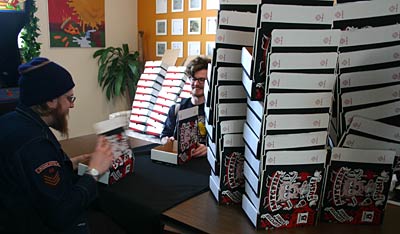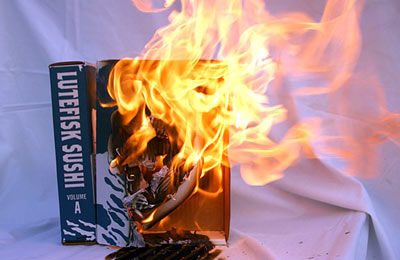
Above: Tim Sievert and Brett VonSchlosser work on collating mini-comics into Lutefisk Sushi Volume B boxes in a photo by Shad Petosky from the Big Time Attic blog.
In my post on Cartoonist Parlour Games yesterday, Tim Maloney commented that the collaborative mini-comics box set is another cartoonist parlour game (he recently was involved in making the The Bog Box Golden Treasury of Minicomics, which looks quite wonderful). I hadn’t been thinking about box sets in those terms previously, but it definitely makes sense.
We’ve had great success with mini-comic box sets in the Minneapolis cell of the Cartoonist Conspiracy, so I thought I’d talk a bit about how to organize your own box sets (maybe this will turn into notes for another volume of the Cartoonist Conspiracy Li’l Library eventually).
We’ve produced four box sets in Minneapolis. Two were collections of mini-comics by Minnesota cartoonists called Lutefisk Sushi Volume A (circa 2004, numbered edition of 100) and Volume B (circa 2006, numbered edition of 150). These were tied into some spectacular gallery shows of the same at Creative Electric Studios. We also used box sets to collect mini-comics from the last two 24 Hour Comic events we had in Minneapolis in 2005 and 2006 (in 2004 we collected 24 hour comics from our event as a book, which is a considerably more complex and expensive thing to pull off).
GREAT REASONS TO MAKE A MINI-COMICS BOX SET
- It is very economical. As opposed to printing an anthology, you only need to supply a box rather than paying for an entire print job. Contributors can print their own books to put in the box.
- Again, unlike a book anthology, a box can hold a wide variety of formats. In our boxes, we’ve had all kinds of sizes and shapes… one that was in a plastic bag with glitter, one that included a magnifying glass, and one that was a scroll hand-silkscreened in invisible ink. Obviously, you can’t do this with a book.
- The anthology format of most box sets makes it so people can try work by a wide variety of artists, which is a great way to turn people on to a lot of exciting work.
- It’s a fantastic way to collect the work of cartoonists from a 24 hour comic event… if event hosts organize a box set in conjunction with their event, they can really step the whole thing up a notch.
- If you’ve produced a lot of mini-comics on your own, packaging them as a box set can help you sell more of them to package a bunch of them together at a lower price than the cover price of the individual minis.
- They can be amazing for fund-raisers. With our two Lutefisk Sushi shows the Minneapolis Cartoonist Conspiracy made around $2000 that we sent to the Comic Book Legal Defense Fund. With Volume B the money we donated we gave in the form of memberships to the CBLDF for participants in the box set.
LIMITATIONS OF THE BOX SET ANTHOLOGY
The major limitation of the box set collection is that it would be very difficult to pull off without a pretty limited print run. These are all put together by hand, and it gets harder to pull off the more of them that you make. 100 seems to be the sweet spot, but we did 150 for the Lutefisk Sushi Volume B show. If people are contributing comics to your box set, you want to keep their print runs affordable too, and printing mini-comics can get expensive (and time consuming if they are elaborate mini-comics, of course). 100 copies won’t break most people’s banks.
Obviously, for the same reasons, you can’t really go back to press on one of these sets generally.
However, the limited print runs and hand-made factor also make these very collectible objects. Number them like you would with a limited edition print to emphasize the limited nature.
STEP ONE: FIND SOME COLLABORATORS
Unless you are planning a collection of your own work, you’ll want a lot of people to work with on this project. With box set anthologies, “the more the merrier” is definitely true. Additional collaborators add MUCH more to the value of the box than the negligible costs involved by including them.
Besides your cartoonist friends, the internet is definitely the best way to find cartoonists to participate. I like to think that The International Cartoonist Conspiracy website is the best place to look.
The Cartoonist Conspiracy is open to all cartoonists, and includes professional and amateur cartoonists in its ranks… anyone with any interest in making comics can join. Additionally, anyone can start a cell in their community… contact me if you want to start one and I’ll get you set up (I’m the Cartoonist Conspiracy webmaster). You can organize your group utilizing our message board.
We currently have cells in Minneapolis MN, San Francisco CA, Calgary/Edmonton, Chicago IL, Lancaster PA, Milwaukee WI, Montreal, Rice MN, Sacramento CA, Sioux Falls SD, Springfield IL, Kansas City MO, Santa Fe/Albuquerque NM, and North Carolina.
If you don’t want to go through us, there are plenty of other places to find collaborators as well… posting on the Comics Journal message board will also probably get you some good results.
STEP TWO: DEFINE YOUR GOALS
Do you want your box set to have a theme? While I would advise against making a theme that is too narrow, like “Comics About French Poodles” or something, because you will have less people contribute than if you have a broad theme. The theme of “mini-comics by cartoonists living in Minnesota” worked very well for our Lutefisk Sushi anthologies (we had over 30 cartoonists participating in volume A and had 50 cartoonists participating in volume B). If you let people use mini-comics that they have already produced in the box, you will probably get more submissions… although it is always good to encourage new work! Some other questions to consider:
- Do you want to organize it around a gallery show?
- How many copies do you want to make?
- How are you going to put the boxes together and print them?
- How will you promote and distribute them?
- How many copies will collaborators get?
- How many boxes do you want to make?
- If you make a profit, what will you do with the money? You may want to consider organizing this for a charity.
You’ll want to discuss these and other logistics with your collaborators before getting started.
STEP THREE: ANNOUNCE A DEADLINE AND GET PEOPLE STARTED
Put the word out about what you are looking for and when you want it by. Things to note:
- If you have a theme, let people know it.
- Are there any format guidelines or restrictions they should know about.
- Do you want people to sign their mini-comics?
- Give people a size limit… so far we’ve used boxes that will fit comics up to 5.5″x8″, but you may want to go for a smaller or bigger box.
- How many copies do they need to contribute?
- How many copies of the box set will they get for participating?
- Will you want their help with collating, printing, or anything else? You should! Let them know.
- Make a hard deadline date. I recommend making this date earlier than you actually need it. That way, when people email you enmasse the day of the deadline asking for more time, as they inevitably will, you can afford to give them an extension to secondary deadline.
- If you recruit people who have never before made a comic in their life (which I also recommend pursuing… every artist should try their hands at a mini-comic), refer them to this online “How To Make Mini-Comics” mini-comic.
STEP FOUR: ORDER THE BOXES
There are probably any number of places online to get boxes. We’ve used this site… note that they have some sweet spots in some of their pricing on certain types of boxes and quantities that you may want to look for if you use them.
Other than for the first Sushi show, we used this box. Here are a couple other good, inexpensive ones.
STEP FIVE: PRINT THE BOXES
We’ve used two methods for covering the boxes. For the Lutefisk Sushi shows we silkscreened wraparound covers, for the 24 hour boxes we printed stickers that we adhered on the covers. You could do a number of other things as well. A printed band around the box could look really cool, you could draw the covers by hand with crayon, you could use a rubber stamp… if you have a gocco machine, that would work great (unfortunately these wonderful devices are no longer being manufactured, although you can still find some supplies for them at Wet Paint Art). The sky is the limit.
You can see a video of Lutefisk Sushi Volume B boxes being hand silkscreened by Lonny Unitus and Shad Petosky here.
STEP SIX: COLLATE THE BOXES
You’ll want to get a bunch of your collaborators to help with this. It will probably go something like this:
- Number all the boxes.
- Fold all the boxes into box form.
- Put all of your mini-comics in stacks by comic around a big table or two.
- Have people grab a box, and walk around the tables putting one of each comic into the box, one comic at a time. Take it slow, you REALLY don’t want to have to do this twice.
- When all the comics are in a box, close the box and add it to the box pile.
STEP SEVEN: DISTRIBUTE THE BOXES
Every participant should get at least one box, depending on the number of participants and the print run.
Beyond that, the best way to sell them, in my view, is in conjunction with a gallery show featuring work from the box on walls. Putting together a comics gallery show is a whole separate beast that I’ll probably post another how-to about sooner or later.
The other major ways to sell them would be to take them to your local comic shops and comic conventions. You can also offer them for sale to some of the fine mini-comics distributors that can be found around the web. Here are some of them:
STEP 8: BURN THE BOXES

Just kidding about that one…
Besides the coolness of the finished mini-comics box, this project is a really great way to get to know cartoonists in your area and build relationships for fruitful collaborations. Good luck!
Have you ever made a mini-comics box? Are you planning to make one? Let us hear about your experiences in the comments!

Pingback: 24 Hour Day Box Set Collections · 24 Hour Comics Day